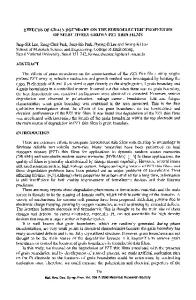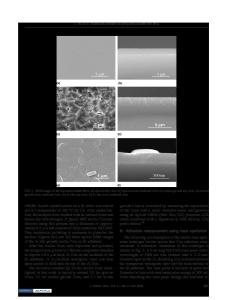Grain Size Effects on the Adhesion of Thin Ductile Films
- PDF / 1,221,385 Bytes
- 6 Pages / 612 x 792 pts (letter) Page_size
- 76 Downloads / 342 Views
U7.4.1
Grain Size Effects on the Adhesion of Thin Ductile Films M.J. Cordill, T. Muppidi, and D.F. Bahr School of Mechanical and Materials Engineering, Washington State University, Pullman, WA ABSTRACT Grain size can be controlled by varying the process conditions used to deposit the film and post growth processing. This study examines how the grain size will impact the mechanical properties, hardness and adhesion, of thin ductile films on brittle substrates. The grain structures of copper and tin films were examined using OIM and AFM. The interfacial fracture toughness of each film was calculated using a tungsten overlayer and mechanics based models. The hardnesses of the films were correlated to the measured interfacial fracture toughness, and demonstrate that increased hardness correlates to an increased sensitivity to the Mode II component of loading. INTRODUCTION Adhesion of thin metal films is important to the microelectronics industry. It has been shown that thickness affects the adhesion properties of thin films [1-2]. As the thickness of a film increases the amount of plastic deformation also increases. This increase in the plastic deformation increases the measured interfacial fracture toughness due to an increase in energy dissipation in the Mode II component of loading. When the thickness increases the grain size changes as well. A relationship exists between the grain size of a material and the material mechanical properties, such as hardness and yield stress, called the Hall-Petch equation [3]. The Hall-Petch relationship is −1 (1) σ = σ + kD 2 o
i
where σo is the yield stress, σi is the friction stress that represents the overall resistance of the dislocation movement, k is a locking parameter which measures the relative hardening contribution of the grain boundaries, and D is the grain diameter [3]. It shows that as the grain size decreases the stress increases. This is an important concept to understand because of dislocations crossing over grain boundaries. The hardness of materials is the measure of how well the material can resist plastic deformation, the Tabor relationship shows (2) H = 3 ⋅σ o where H is the hardness and σo is the yield stress [4]. The hardness of thin films can be easily determined by using nanoindentation [5]. In this study the continuous stiffness method is used to determine the hardness of copper and tin films. Copper and tin films of varying grain sizes are used to examine the effect that grain size may have on the adhesion energy to a tungsten overlayer. The grain size of the films is controlled by deposition and post deposition processes. This paper shows the effect of grain size (and hardness) and the adhesion of ductile films of the same thickness, which will impact future generation devices as the grain size metallization reaches nanometer sizes. MATERIALS AND ADHESION MECHANICS The copper films used in this study were commercial films supplied by AMD and were 750 nm in thickness. Copper films were electroplated onto a 100 angstrom sputter deposited
Downloaded from
Data Loading...










